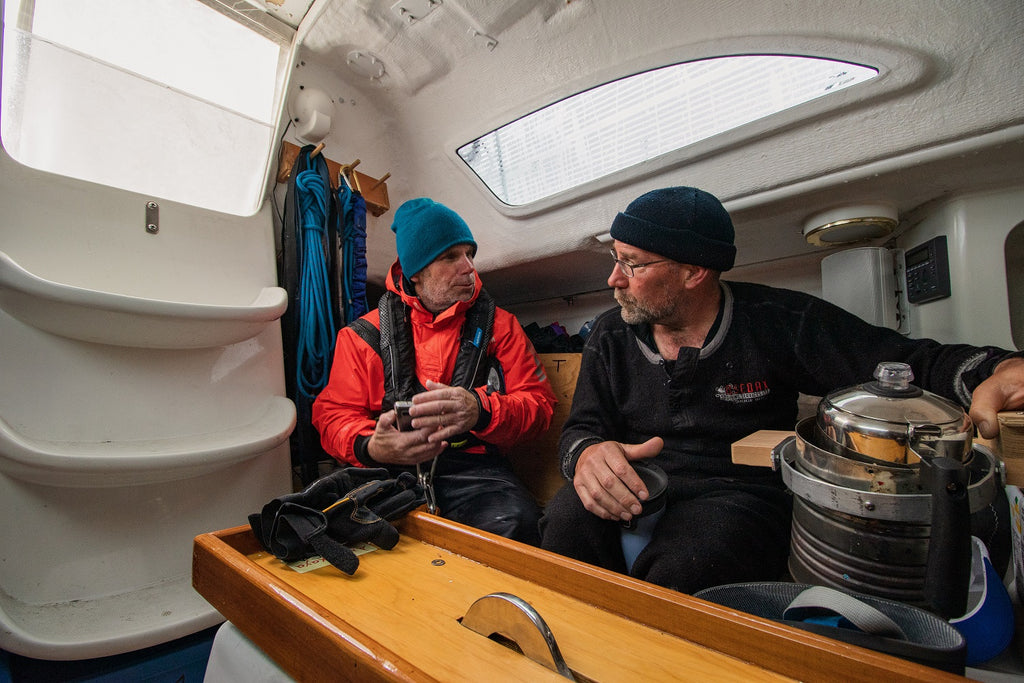
Proving Ground
At sunset on the fourth day of a nonstop circumnavigation around Vancouver Island, all six men aboard Amurskaya—a Flying Tiger 10 meter—had come out on deck to enjoy a perfect view.
The sun had softened to an orange glow against a dark silhouette of the landmass, and a rainbow stretched across their course. At the helm, Mike Bowick called for a gybe.
As the team eased Amurskaya over to a starboard tack, a pair of humpback whales breached straight in front of the boat. For a split second, everyone froze. Roger Hassol recovered first.
“Turn the boat, turn the boat!” he yelled.
Bowick sprang to action, yanking the tiller back, which sent the boom and anything that wasn’t bolted down crashing to the other side. But he missed the whales.
“We think it was a mom and calf,” says Jay Blackmore. “We could have reached out and scratched their backs.” The near-collision left the crew shaken, but they all agreed that such moments were the reason they were there. A whale in their path was something they never could have replicated while training at home on Kootenay Lake in the British Columbia interior.

Blackmore and team are based in Nelson, in the Selkirk Mountains. They call themselves the Kootenay Pedalwheelers, and were one of the 32 teams originally slated to compete in the 2020 Race to Alaska (R2AK); a 750-mile, non-motorized, self-supported race from Port Townsend, Washington to Ketchikan, Alaska.
When the race was cancelled due to the COVID-19 pandemic, the Kootenay Pedalwheelers set their sights on the 2021 event, and in between, aspired to get Amurskaya off the lake and into the ocean to practice.
In June, as British Columbia moved to Phase 3 of the province’s reopening, the Kootenay Pedalwheelers got their first chance. They chose a circumnavigation of Vancouver Island as it provides ample opportunity to experience open water along the rugged west coast.

And, also because they could do the route nonstop by starting and ending at a friend’s place on Bowen Island, thus avoiding direct contact with anyone outside their six-person pod, as per British Columbia’s social distancing recommendations. That included the rigging: Mike Bowick rigged a gin pole so the team could hoist the mast themselves.
During the circumnavigation, the Kootenay Pedalwheelers tested the continuous sailing schedule they intend to use at R2AK. They split their six-man team into three pairs. Each pair rotated through three 4-hour shifts. Shift one was sailing, shift two was sailing support, and shift three was eating and sleeping. That equated to 8 hours of work followed by 4 hours of rest.
The midnight to 8:00 a.m. stretch proved the toughest. “It’s cold, it’s wet, and you need to stay focused and keep the boat moving,” says Blackmore. “It’s brutal, but it’s doable.”
Read more about the extraordinary race to Alaska event

Other valuable lessons included first-hand proof that mountain lakes aren’t the only places where wind behaves unexpectedly. Coming around the Brooks Peninsula, a site that regularly reports the highest wind strengths on the coast, the Kootenay Pedalwheelers found none.
“We did a significant amount of pedaling around the outside, which we never expected,” says Blackmore.
The team put in a total of 20 hours of pedaling in the eight days they spent on the water.
Blackmore reports that the pedal drives—a pair of steel bike frames that pedal propellers—worked perfectly. Except while moving through bull kelp. “That stuff is horrible,” he says. “It was getting snagged around the keel, and it fouls the bicycle propellers.”

For our Entire Line of Foul Weather and Waterproof Gear, Visit the Shop Today
For R2AK, the Kootenay Pedalwheelers plan to mount a waterproof GoPro to a pole and insert it into the water to monitor bull kelp. It will be Blackmore’s job to don a drysuit and jump overboard with a knife to cut it away.
Most importantly, the Kootenay Pedalwheelers were able to get Amurskaya out on the open ocean and really see what the boat could do. “We struggled at high speeds sailing the boat on Kootenay Lake,” Blackmore says. “But when we were able to get out on a larger body of water with a steady swell and steady wind that wasn’t constantly swirling and switching around, we were able to fly.”
The team’s stoke for R2AK 2021 is at an all-time high. “We are going to be so much better prepared and I think mentally ready for everything it’s going to throw at us,” Blackmore says.

Jayme Moye writes about travel, mountain sports and culture, and pushing the limits of human potential. Her award-winning freelance work appears in National Geographic, Outside Magazine, Adventure Journal, and Travel + Leisure, among others.